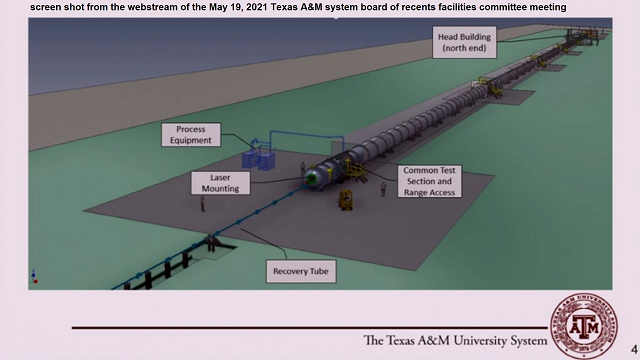
Hypersonic research and construction of a hypersonic testing range continue on the RELLIS campus.
The Texas A&M Engineering Experiment Station (TEES) is one of 18 university-led research teams to receive a $1.5 million grant from the Joint Hypersonic Transition Office (JHTO).
Another key to TEES’s hypersonic research is the BAM facility, which is being built at RELLIS.
Col. Ross Guieb, Executive Director for the Bush Combat Development Complex, says construction of the facility is on schedule to be complete in the spring of 2023.
Col. Ross Guieb and Dr. Rodney Bowersox, Associate dean for research, Texas A&M Engineering Experiment Station, visited with WTAW’s Chelsea Reber.
News release from Texas A&M University:
Proposals from 18 U.S. university-led research teams from the University Consortium for Applied Hypersonics (UCAH), totaling $25.5 million, were selected as awardees for prototyping contracts by the Joint Hypersonics Transition Office (JHTO). The teams include participation from U.S. industry, national labs, federally funded research and development centers, university-affiliated research centers and Australian universities.
“This year’s awardees represent outstanding research proposals from our consortium members,” said Dr. Gillian Bussey, director, JHTO. “The research they are working on is aligned with our goals and will have a major impact on advancing the field of hypersonics.”
The following are the awardees for the first project call:
- University of Illinois at Urbana-Champaign: Non-Destructive Testing for Hypersonics Materials Manufacturing of Carbon/Carbon Composites
- Georgia Institute of Technology: Machine Learning Enhanced Ultrasonic Inspection for Non-Destructive Characterization of Manufacturing Defects in Hypersonic Materials
- North Carolina Agricultural and Technical: Impact Welding and Phase Change Enabled Sealing of High Temperature Metal-Composite Interfaces
- Georgia Institute of Technology: Improved Window and Radome Material Testing for Hypersonic Vehicle Sensors and Seekers.
- University of Virginia: Additive Manufacturing of High-Performance Niobium Alloys Components for Scramjet Applications: Going Beyond Alloy C103
- Georgia Institute of Technology: Development and Experimental Validation of Multi-Modal Control for Rapidly-Changing Flight Dynamics
- Pennsylvania State University: Next Generation Numerical Methods for High-Fidelity Trajectory Generation for Hypersonic Vehicles
- University of Michigan: Robust Adaptive Control of a Dual-Mode Scramjet with Targeted Uncertainty Quantification
- University of Central Florida: High-Performance Solid-Fuels for Hypersonic Air Breathing Propulsion
- The University of Texas at Arlington: Experimental and Numerical Investigation of Directed Energy Radiation Interactions for Hypersonic Applications
- University of Arizona: Fusion of Multi-Fidelity Experimental and Computational Data for the Construction and Enrichment of a Surrogate Aerodynamic Database
- United States Air Force Academy: Free Flight Wind Tunnel Experiments and Simulations for Control Jet Applications in Hypersonic Flows
- Texas A&M Engineering Experiment Station: Shock Interface Cooling in Hypersonic Environments
- The University of Texas at San Antonio: Modeling and Experimental Measurements of Hypersonic Separation Events
- Air Force Institute of Technology: Efficient Multidisciplinary Optimization Methodologies for Hypersonic Systems
- Johns Hopkins University: Machine-Learning Informed Topology Optimization for Multiscale Design of Cellular Structures
- University of Iowa: Energetic Materials Selection and Micro-Structural Design for Robust Performance Under Damage Scenarios
- University of Alabama-Huntsville: Solid Fuel Rotating Detonation Ramjet Engine for Hypersonic Air-Breathing Propulsion
This is the first in a series of planned solicitations from JHTO through UCAH over the next four years. For more information about open solicitations, see https://hypersonics.tamu.edu/project-call/.
News release from the Bush Combat Development Complex:
On Sept. 30, the Texas A&M Engineering Experiment Station (TEES) transitioned from the $65 million cooperative agreement awarded in 2019 to an up to $96.2 million, five-year contract from the U.S. Army for its George H.W. Bush Combat Development Complex (BCDC) to continue research and technology development in support of critical military modernization priorities through 2026.
The contract proposal, titled “High-Impact Mission-Oriented Research and Innovation,” is focused on continued innovation in five technology areas:
- Laser Diagnostics for Hypersonics and Directed Energy
- Rapid Design of Hypersonic Vehicles
- Materials for Extreme Environments
- Coordinated Air-Ground Vehicle Maneuvering
- Resilient Real-time Network Architectures for Autonomous Vehicle Communications
The contract agreement between the Army and TEES authorizes up to $96.2 million in research expenditures and allows for research efforts that may also be of interest to other government agencies/organizations.
The approach for research conducted by subject matter experts at BCDC supports multi-disciplinary engineering research, coupled with The Texas A&M University System’s cutting-edge facilities at its RELLIS Campus, and demonstrates how TEES is proving itself as a committed partner in military modernization efforts.
“Over the past two years, our strategic partnership with Army Futures Command has proven valuable as we work together on solutions for Army modernization research priorities,” said Dr. M. Katherine Banks, Texas A&M University president and vice chancellor for national security initiatives. “Our vision for BCDC has become a reality and we are proud to collaborate with the Army to protect our nation, both now and into the future.”
TEES established BCDC in 2019 through a three-part investment of more than $200 million between the Army Futures Command, with $65 million for research and research equipment; the Texas Legislature, with $50 million for instrumentation of a test-bed known as the Innovation Proving Ground (IPG) as well as a Ballistic-Aero optic and Materials (BAM) hypersonic test-range; and the Texas A&M System, for capital construction of a facility known as the Research Integration Center.
The Research Integration Center, commonly known as the RIC, serves as the headquarters for BCDC and as a research facility primarily designed for developing and evaluating autonomous systems. The RIC was completed last month (within two years of its groundbreaking). Construction is well underway for the IPG (to be fully operational by fall 2022) and an initial stage of the BAM (to be complete by spring 2023). Together, this ecosystem of researchers and facilities is becoming one of the top state-of-the-art national security-related research and testing organizations in the U.S.
“We are pleased with the confidence that Army shows in the Texas A&M System,” Chancellor John Sharp said. “This contract illustrates that we are well on the way to deliver a world-class testing complex, which will accelerate military innovation for generations to come.”
Congressman Pete Sessions (TX-17) applauded the new contract.
“I am proud of Chancellor Sharp and President Banks for working with the Department of Defense to bring these federal dollars home to develop hypersonic systems and networked autonomous vehicles for the U.S. Army at the RELLIS Campus in Bryan,” Sessions said. “I am fully supportive as the university expands its capacity to provide our U.S. military with important technologies that also will boost industrial and economic development here in the 17th Congressional District of Texas.”
